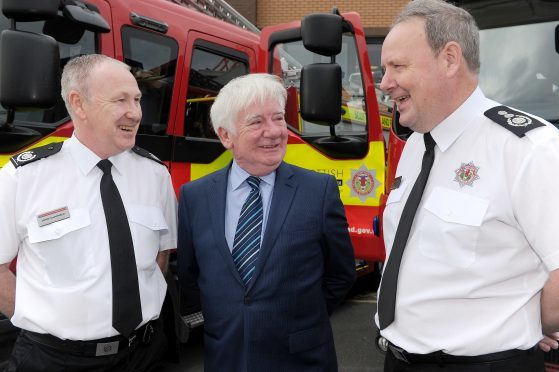Scotland’s fire chief has pledged a growing commitment to the Highlands and islands yesterday – and revealed the service is doubling their investment on new engines, property and equipment in the region.
The Chief Fire Officer of the Scottish Fire and Rescue Service, Alasdair Hay, said the north of Scotland was being made a priority regarding the replacement of fleet and the upgrading of property and equipment – with just over £6million being invested this financial year.
After an annual ministerial performance review in Inverness with Community Safety Minister Annabelle Ewing, he stressed: “We are targeting areas of greater need, and the Highlands and Islands is in that category.”
Mr Hay said that, prior to the controversial merger of eight regional fire services four years ago, only 8% of the total spend on such infrastructure went to the Highlands and Islands service.
He added: “We are now investing, in capital, 16% of a £40million budget to try to address some specific issues relating to the Highlands and Islands area.”
Mr Hay revealed that when the new service was launched in 2013 they inherited a backlog requiring £171million of investment across the whole of Scotland, adding: “That is a huge amount of money, but we are now making inroads.
“We are not going to fix it quickly, but I can give an assurance to the people in the Highlands and Islands of the commitment we have to the area by doubling the amount we spend.”
He admitted that many stations did not even have a toilet when the SFRS first launched, but portable toilets have now been put in place.
SFRS is the only UK fire service which still pays 20% VAT due to historic political decisions.
Pat Watters, chair of the SFRS Board which met Annabelle Ewing yetserday, added: “While we are making a 16% commitment to Highland communities it could have been so much more if 20% was not going to the Treasury.
“To put that into perspective, if we did not have this burden then the new £3million station built in Stornoway would have cost £2.4million.
“Don’t tell me that it is right that people in the Highlands have to pay 20% more than the people of, say, Lancaster.”
Rhoda Grant, Highlands and Islands Labour, said: “While it is good to hear that more money is being invested in capital projects in the Highlands and Islands, there is still a long way to go to ensure our remote and rural areas have the equipment and retained firefighter cover that they deserve.
“It was pleasing to hear of some very positive ideas for developing the retained firefighter service in the region, both to enhance staff recruitment, help staff retention and through using new technology.
“However, Audit Scotland has estimated that the Fire and Rescue Budget will decrease by 31 per cent between 2012 and 2020, stoking fears of greater job cuts and more closures to stations.”
Scottish Fire and Rescue Service (SFRS) has already significantly increased its spending in the north while also doubling the number of fleet inspections, improving the quality and safety of fire service vehicles.
Western Isles communities have benefitted from a near £3million investment to modernise the Stornoway station and deliver vital modern training facilities.
The Aberlour retained station has benefited from a new fire appliance, which was part of a £3.8million investment by the service into its fleet. The new vehicle is state-of-the-art and will enhance service delivery in and around Aberlour and the wider Moray area. An investment of more than £100,000 saw Cannich also take delivery of a new fire appliance.
And there were also two new appliances in Inverness, one in Kingussie, one in Tain and two in Aberdeen city.
The SFRS invested £1million on the North headquarters at Dyce fire station in Aberdeen, serving Highland, Shetland, Orkney and the Western Isles, as well as Perth and Kinross, Dundee and Angus, and Aberdeenshire and Moray.
And just last week, a new £2.5m state-of-the-art Operations Control serving the North of Scotland officially opened in Dundee.
New cadets
Orkney, Shetland and the Western Isles are to pilot an innovative Cadet Scheme for the Scottish Fire and Rescue Service.
The aim of the project is to raise the profile of the service and encourage more young people to think about making a full-time career of it or joining up as a retained firefighter.
If successful, the intention is to roll this out to around 100 cadet schemes across Scotland.
Chief Fire Officer Alasdair Hay made the announcement following the annual ministerial performance review, attended by Community Safety Minister Annabelle Ewing.
He said the fire service had provided funding for three full-time posts.
The hope is that many who train as cadets will go on to fill much needed retained firefighting posts in rural communities, or even join the fire and rescue service.
The meeting of the Scottish Fire and Rescue Service board took place at Inverness Caledonian Thistle’s football stadium.
The annual review showed there were 887 fire fatalities in 2016/17, down significantly from 1,058 the previous year.
The number of accidental dwelling fires had dropped to 4,922 from 5,072, while non-domestic fires also fell from 2,497 to 2,279.
Annabelle Ewing praised the work done by the service since the controversial merger of eight regional services in to one single service four years ago.
She added: “The Scottish Fire and Rescue Service’s continued commitment to prevention, protection and response has played an important part in the decrease in the total number of fires in Scotland over the last decade.”
“Our fire framework, published last year, sets out Scottish Ministers ambitions and priorities for a world leading fire and rescue service over the next few years, as we move out of the period of reform and into a period of transformation.
“The strategic priorities represent out high level ambition for what we want from a modern, skilled and dynamic fire and rescue service.”
